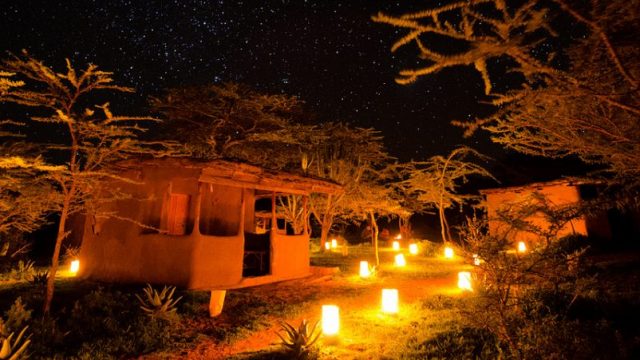For over a century, Kenya’s sandy beaches, breathtaking natural scenery and diverse wildlife have attracted tourists to the continent. But the presence of visitors, with their accompanying transportation needs and sometimes anti-social behaviors (such as littering), began having a negative impact on tourist attractions.
This, combined with poaching, smuggling, and locals’ hearty appetite for “bush meat,” led to dwindling numbers of Kenya’s signature wildlife.
Luckily, by the late 1990s the ‘gospel’ of ecotourism had arrived in Kenya. Since then the country has experienced a general shift towards more aggressive measures in environmental conservation, and adopted practices that emphasize low-impact activities that leave attractions in their virgin state.
In Kenya, eco-tourism has slowly grown from an abstract concept to a more niche-driven market that attracts both repeat customers and new clients. While some tourist sites blend the traditional tourism with more environment-friendly tourist activities, there are a number of establishments that fashion themselves as exclusive eco-tourism sites.
Touring Kenya and staying at an eco-rated property is a way of supporting environment and natural resource conservation activities for posterity.
One such place is the Murera Springs Eco Lodge in Meru, a small town located about 150 miles to the north east of Kenya’s capital, Nairobi.
Murera Springs is an artistically crafted tourist lodge at the foot of Mount Kenya. All electricity is supplied by solar panels and the cuisine is made from vegetables grown around the area. Waste water is recycled and used for irrigating the grasses and gardens around the lodge. In this way, this eco-lodge is a self-sustaining circuit.
The lodge is in close proximity to the Meru National Park, which ranks among the most enticing tourism destinations in East Africa. The history of this area is closely tied with conservationism.
The widely acclaimed movie Born Free is based on a true story set in Meru. The film tells the story of George Adamson, who together with his wife Joy, raised an orphaned lion cub known as Elsa the Lioness and eventually released her into the wild when she was an adult.
Meru borders Kora National Park to the southeast, which is associated with another famous lion, Christian the Lion. The lion, formerly a captive cub in London in the 1970s, was relocated to George Adamson’s compound in Kora by his one-time owners, John Rendall and Anthony Bourke. Their joyful reunion with Christian a year later at Kora was documented in a YouTube video that has so far garnered over 100 million views.
Maji Moto Eco Camp near Diani is another example of a signature eco-tourism project that benefits both the environment and local people. All structures at Maji Moto, which is operated by the Masai people, were built Masai-style, using only local materials such as branches, stalks, grass, cow dung and stone (no trees were felled for construction). There is no electricity in the camp, and water for showers is brought in from a nearby hot spring — so no heating is required.
Several other establishments – for example the Bamburi Nature Trail and the Lewa Conservancy in Northern Kenya – have followed the eco-tourism trend.
The Bamburi Nature Trail, in Mombasa’s Haller Park, is a small wildlife sanctuary that was built from a former limestone quarry and cement factory. It is a great attraction for lovers of birds, game animals and exotic trees and features a crocodile sanctuary, a reptile park with giant tortoises, and place to feed giraffes. Guided tours take visitors through the Bamburi Forest.
The Lewa Conservancy, located in the foothills of Mt. Kenya, offers the same thing, but on a much larger scale. This 55,000-acre sanctuary is home to some of the continent’s most endangered species – the black rhino and the Grevy’s zebra– and other wildlife including elephants, giraffes, buffalo, antelopes, lions, cheetahs and leopard. Lewa also hosts an annual marathon in the wilderness with the aim of raising awareness and funds for wildlife protection efforts.
The enormous support for ecotourism in Kenya comes not only from the government and people, but also from companies committed to preserving Kenya’s natural resources and empowering local communities. Basecamp Foundation, for instance, is a nonprofit that works with host communities and partner organizations to set up “sustainable destinations” in Kenya and other developing countries, highlighting the positive effects tourism can have on the natural, social, and economic environment. Ecotourism Kenya is another organization that devotes much of its resources to raising awareness through community outreach, performing extensive research projects, and ensuring leadership opportunities for local community members.
Kenya’s commitment to sustainable tourism was demonstrated by the launch of an eco-rating scheme by the Eco-Tourism Society of Kenya (ESOK) in 2005. This scheme rates hotels, lodges and camps based on their eco-friendliness. An inventory of eco-tourist projects which can be found on the ESOK website.
In 2003, Readers of the US Recommend Magazine – a publication for travel agents – voted Kenya as the number one worldwide destination for eco-tourism. This award was presented to the Kenya Tourism Board at the American Society of Travel Agents World Congress in Miami.
Undeniably, 2003 is a long time ago but Kenya’s eco-friendly tourism niche continues to grow and gain popularity. In this day and age, where emphasis is put on environmental conservation and the sustainability of our resources for future generations, eco-tourism is only bound to get bigger and bigger.

